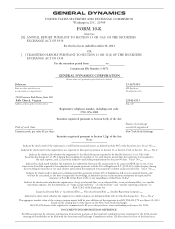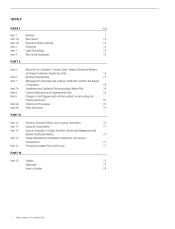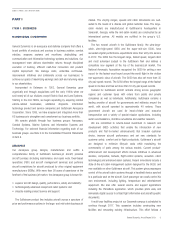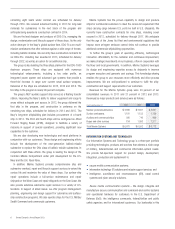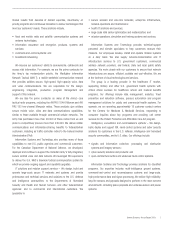General Dynamics 2013 Annual Report Download - page 15
Download and view the complete annual report
Please find page 15 of the 2013 General Dynamics annual report below. You can navigate through the pages in the report by either clicking on the pages listed below, or by using the keyword search tool below to find specific information within the annual report.
REGULATORY MATTERS
U.S. GOVERNMENT CONTRACTS
U.S. government contracts are subject to procurement laws and
regulations. The Federal Acquisition Regulation (FAR) and the Cost
Accounting Standards (CAS) govern the majority of our contracts. The
FAR mandates uniform policies and procedures for U.S. government
acquisitions and purchased services. Also, individual agencies can
have acquisition regulations that provide implementing language for the
FAR or that supplement the FAR. For example, the DoD implements the
FAR through the Defense Federal Acquisition Regulation Supplement
(DFARS). For all federal government entities, the FAR regulates the
phases of any product or service acquisition, including:
•acquisition planning,
•competition requirements,
•contractor qualifications,
•protection of source selection and vendor information, and
•acquisition procedures.
In addition, the FAR addresses the allowability of our costs, while
the CAS address how those costs can be allocated to contracts. The
FAR subjects us to audits and other government reviews covering
issues such as cost, performance and accounting practices relating to
our contracts.
INTERNATIONAL
Our international sales are subject to the applicable foreign government
regulations and procurement policies and practices, as well as U.S.
policies and regulations. We are also subject to regulations governing
investments, exchange controls, repatriation of earnings and import-
export control.
BUSINESS-JET AIRCRAFT
The Aerospace group is subject to FAA regulation in the United States
and other similar aviation regulatory authorities internationally,
including the Civil Aviation Administration of Israel (CAAI), the European
Aviation Safety Agency (EASA) and the Civil Aviation Administration of
China (CAAC). For an aircraft to be manufactured and sold, the model
must receive a type certificate from the appropriate aviation authority
and each aircraft must receive a certificate of airworthiness. Aircraft
outfitting and completions also require approval by the appropriate
aviation authority, which often is accomplished through a supplemental
type certificate. Aviation authorities can require changes to a specific
aircraft or model type before granting approval. Maintenance facilities
and charter operations must be licensed by aviation authorities as well.
ENVIRONMENTAL
We are subject to a variety of federal, state, local and foreign
environmental laws and regulations. These laws and regulations cover
the discharge, treatment, storage, disposal, investigation and
remediation of certain materials, substances and wastes. We are directly
or indirectly involved in environmental investigations or remediation at
some of our current and former facilities and at third-party sites that we
do not own but where we have been designated a Potentially
Responsible Party (PRP) by the U.S. Environmental Protection Agency or
a state environmental agency. As a PRP, we potentially are liable to the
government or third parties for the cost of remediating contamination. In
cases where we have been designated a PRP, generally we seek to
mitigate these environmental liabilities through available insurance
coverage and by pursuing appropriate cost-recovery actions. In the
unlikely event we are required to fully fund the remediation of a site, the
current statutory framework would allow us to pursue contributions from
other PRPs. We regularly assess our compliance status and
management of environmental matters.
Operating and maintenance costs associated with environmental
compliance and management of contaminated sites are a normal,
recurring part of our operations. Historically, these costs have not been
material. Environmental costs often are recoverable under our contracts
with the U.S. government. Based on information currently available and
current U.S. government policies relating to cost recovery, we do not
expect continued compliance with environmental regulations to have a
material impact on our results of operations, financial condition or cash
flows. For additional information relating to the impact of environmental
matters, see Note N to the Consolidated Financial Statements in Item 8.
AVAILABLE INFORMATION
We file several types of reports and other information with the Securities
and Exchange Commission (SEC) pursuant to Section 13(a) or 15(d) of
the Securities Exchange Act of 1934, as amended. These reports and
information include an annual report on Form 10-K, quarterly reports on
Form 10-Q, current reports on Form 8-K and proxy statements. Free
copies of these items are made available on our website
(www.generaldynamics.com) as soon as practicable and through the
General Dynamics investor relations office at (703) 876-3583.
These items also can be read and copied at the SEC’s Public
Reference Room at 100 F Street, N.E., Washington, DC 20549.
Information on the operation of the Public Reference Room is available by
calling the SEC at (800) SEC-0330. The SEC maintains a website
(www.sec.gov) that contains reports, proxy and information statements,
and other information.
General Dynamics Annual Report 2013 11


